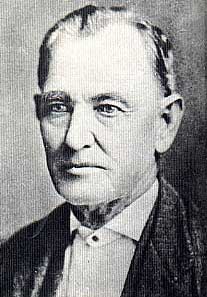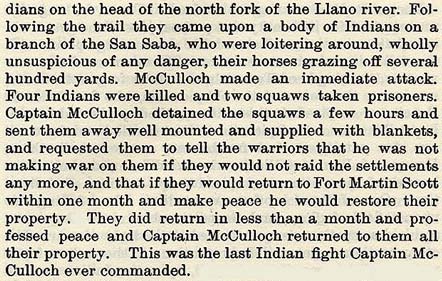Early in August of the above year, scouts of Capt. McCulloch reported
fresh Indian signs and a fresh Indian trail west of their camp, which
was on the north branch of the Llano. Capt. McCulloch and twenty-one
men followed in immediate pursuit and when they reached the south
bank of the San Saba, it became evident that the Indians were near.
The Comanches' camp was soon discovered in a deep ravine. No doubt,
these Indians felt secure so many miles from the settlements and permitted
their horses to graze away for a considerable distance.

General Henry E. McCulloch
After learning the Indians were near the command cautiously proceeded
toward their encampment. Capt. McCulloch and his men, at the critical
moment, made a decisive charge and separated the horses from the Indians,
who took refuge in a nearby ravine. The rangers crowded them as closely
as possible and it was reported the squaws fought with bows and arrows
like they were men. The Indians were finally routed from their position
and retreated down the branch until they found refuge in the brush
below.
After the smoke of battle had cleared away, eight warriors lay dead
on the ground. The rangers recovered their horses and camp equipment
and it was evident the Indian raiders had been robbing the Mexicans
on the Rio Grande. Two captured squaws were also among the spoils
and Capt. McCulloch gave them horses and necessary supplies and told
them to convey the word to Katumpsy, chief of the Comanches, that
if they would bring in such prisoners they had and report at Fort
Martin Scott, their horses would be restored. In response, Katumpsy
contended that he had been warring against the Mexicans only and that
it was not right for the Texans to interfere.


